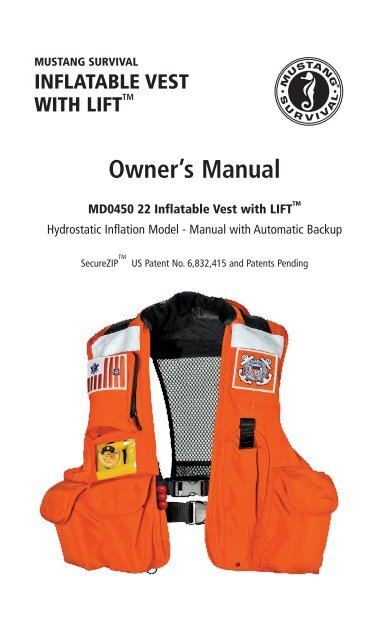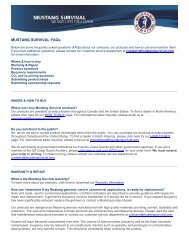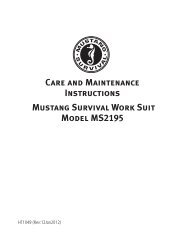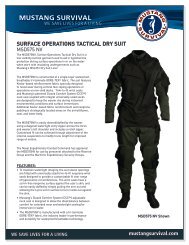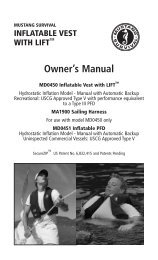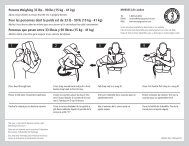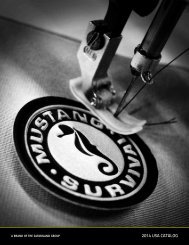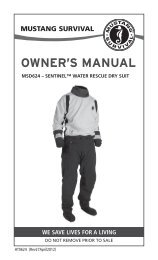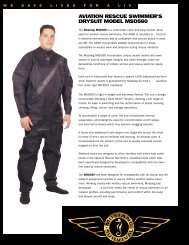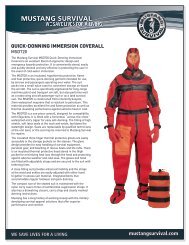Owner's Manual - Mustang Survival
Owner's Manual - Mustang Survival
Owner's Manual - Mustang Survival
You also want an ePaper? Increase the reach of your titles
YUMPU automatically turns print PDFs into web optimized ePapers that Google loves.
CONTENTSPage 1 Introduction1 Why are PFDs Required Safety Equipment?2 What is an Inflatable PFD?3 Instructions for Use3 Component Inspection Instructions4 Readiness Checklist5 Donning Instructions6 Inflation8 In-water Adjustments9 Special Considerations for Automatic Devices10 Deflation10 Usage Below Freezing11 Re-arming Your PFD15 Auto/<strong>Manual</strong> Conversion Cap (MA7219) Instructions15 Conversion Instructions17 Repacking23 Is Your PFD in Good and Serviceable Condition?24 Care and Maintenance Instructions26 Cleaning and Storing26 How and Why to Test Your PFD27 How Do You Test Your PFD Using the Automatic Inflator?27 How Do You Test Your PFD Using the <strong>Manual</strong> Inflator?28 How Do You Test Your PFD Using the Oral Inflator?29 Wear Your PFD30 Hypothermia31 Each of These Devices is Intended to Help You Save Your Life32 Safety Accessories32 Do Not Attach PFDs to Your Boat32 Airline Operator Policy on Carriage of Inflatable PFDsInflatable Vest with LIFT TM Owner’s <strong>Manual</strong>i
INTRODUCTIONThe MD0450 22 requires user involvement to ensure a level of safetyequal to other inflatable PFDs. Knowledgeable users increase their safetysignificantly by wearing and using these PFDs as prescribed in thisowner’s manual.General - This Inflatable PFD will turn most wearers from a facedown to a face up position and provide support suitable for offshoreconditions. See page 11 for re-arming instructions.This Inflatable PFD was designed to be more comfortable and lessrestrictive to wear than inherently buoyant PFDs. When worn, used andserviced according to this owner’s manual, this PFD can greatly increaseyour chances of survival in the water. Not recommended for nonswimmersor weak swimmers.To be considered serviceable, this PFD shall not exhibit deteriorationthat could diminish its performance such as broken or deformedhardware, detached webbing, rotted structural components, air leaks,or nonfunctional oral inflation tube. Unless worn inflated, this PFD mustalso be properly armed with a full CO 2 cylinder, inflation system statusindicator, and a manual inflation beaded handle accessible outside theuser’s right front panel cover (Fig. 1). The chest buckle, on the InflatableVest with LIFT TM , must be fastened after inflation.WHY ARE PFDS REQUIRED SAFETY EQUIPMENT?Drownings are the leading cause of fatalities involving recreational andcommercial vessels. A PFD provides flotation to help keep your headabove water, help you to stay face up in the water, and increase yourchances for survival and rescue. Most adults only need an extra 7 to 12kg (3.2 to 5.5 pounds) of flotation to keep their heads above water. Theproper size PFD will properly support the weight of the wearer.Since this Inflatable PFD does not have inherent buoyancy, it providesflotation only when inflated. Familiarize yourself with the use of this1 MUSTANG SURVIVAL
Inflatable PFD so you know what to do in an emergency.WHAT IS AN INFLATABLE PFD?Congratulations on the purchase of your Inflatable Vest with PatentPending LIFT TM [Life-saving Inflatable Flotation Technology]. LIFT TM isdifferent from all other inflatable PFD’s. In general, inflatable PFD’s aredesigned to suspend a user’s head above water to prevent drowning.The Inflatable Vest with LIFT TM provides freeboard that far exceeds theminimal 3” generally provided. LIFT TM elevates you to an upright safeposition and delivers up to 9” of freeboard, the highest ever seen ina PFD, keeping your mouth high above the water line to minimize therisk of mouth immersions. Not only is LIFT TM one of the world’s bestperforming PFD’s in wave conditions, but it’s comfortable too. Light andergonomically designed – you can’t even tell you’re wearing it until youneed it.While traditional PFDs are inherently buoyant, inflatable PFDs like theInflatable Vest with LIFT TM rely entirely upon inflation for buoyancy.Uninflated, the Inflatable Vest with LIFT TM is comfortable and can beinflated at any time with a 38-gram CO 2 gas cylinder. The Inflatable Vestwith LIFT TM is designed to meet the demands of a full protection PFDoffering maximum mobility with minimum bulk. The Inflatable Vest withLIFT TM can be inflated either automatically during immersion, manuallyby pulling a beaded handle, or by mouth. It is imperative that youfamiliarize yourself with the procedures outlined in INSTRUCTIONS FORUSE (p. 3).Inflatable Vest with LIFT TM Owner’s <strong>Manual</strong> 2
INSTRUCTIONS FOR USEThis manual supplies instructional, maintenance and safety informationfor model MD0450 22 unless specified otherwise. The model number islisted on the label.FIGURE 1MD0450 UnpackedOral InflatorWindowCover PanelFOLD #1HydrostaticInflatorFOLD #3Chest StrapChest Velcro TabBuckleFOLD #3FOLD #1FOLD #2BeadedHandleWaist BeltFOLD #2Right LobeFront BuckleLeft LobeFIGURE 2Hydrostatic Inflator CapWater Inlet ValveBlack Locking RingSinglePointStatusIndicatorInflatorBodyExpiryDateYellow Inflator CapCap/Locking RingTabsLanyardBeadedHandleComponent Inspection Instructions1) Examine the single point indicator through the window panel. Ensurethe single point indicator is green. If the single point indicator is red,the mechanism has been fired or is incorrectly fitted (Fig. 2). See3 MUSTANG SURVIVAL
RE-ARMING YOUR PFD (p. 11).NOTE: The single point indicator must be green beforeproceeding.2) Open the cover at wearer’s right-hand side of the chest and lay thedevice flat.3) Ensure the oral-inflation dust cap is in the stowed position (Fig. 22).4) Ensure the single point indicator is green and the beaded handle isattached to it’s Velcro tab; secure the zippers on the Inflatable Vestwith LIFT TM (see Repacking, p. 17).5) Ensure the date on the inflator is not five years or older (Fig. 2). If itis, replace the inflator (see Re-arming Your PFD, p. 11).Readiness ChecklistCheck your Inflatable Vest with LIFT TM and ensure all of the checkpointslisted below are true before each use.■ Single point indicator is green.■ Ensure the current date is not past the date on the inflator. If it is,replace the inflator (see Re-arming Your PFD, p. 11).■ All zippers, Velcro and waist buckle are securely fastened.■ Inflatable Vest with LIFT TM is not twisted.■ Oral-inflation dust cap is in the stowed position (Fig. 22).■ Ensure the beaded handle is placed through the opening and isattached to the Velcro tab on the outside of the vest (Fig. 35).■ No rips, tears or holes; all seams are securely sewn; and the fabric,straps and hardware are still strong.Your Inflatable Vest with LIFT TM is ready for use if all boxes are checked.NOTE: Contact your <strong>Mustang</strong> Dealer if you have any concernsabout the readiness of your Inflatable Vest with LIFT TM .Inflatable Vest with LIFT TM Owner’s <strong>Manual</strong> 4
Donning InstructionsIt is important that the PFD is properly adjusted to fit the person wearingit. An incorrect fit or improper fastening of attachments could reduce itseffectiveness.1) Put the Inflatable Vest with LIFT TM on just like a jacket (Fig. 3). Ifthe Inflatable Vest with LIFT TM is already inflated prior to donning,it may be excessively tight while donning. If so, expel some air bydepressing the oral tube valve, don the Inflatable Vest with LIFT TM ,and refill Inflatable Vest with LIFT TM by mouth using the oral tube.2) Fasten the front waist belt buckle (Fig 3). Adjust the waist belt to asecure fit using the front adjuster on the belt.WARNING: Do not wear the Inflatable Vest with LIFT TM underother clothing or harness systems as the inflation could berestricted and you could be injured.FIGURE 3NOTE: Heavy objects in the pockets may cause the PFD to sinkif dropped overboard when not inflated.5 MUSTANG SURVIVAL
3) Fasten the middle buckle (Fig. 4). Adjust the middle belt to a securefit using the front adjuster on the belt.FIGURE 4IMPORTANT: Ensure thechest buckle is fastened,when inflated (Fig. 4).4) Feed the loose end of the waist belt into the belt opening in thestorage pocket (Fig. 5).FIGURE 5InflationIt is recommended that the following procedures be followed to inflateyour Inflatable Vest with LIFT TM .<strong>Manual</strong> Inflation1) Activate the inflation system by grasping the beaded handle and jerkInflatable Vest with LIFT TM Owner’s <strong>Manual</strong> 6
firmly downward. The PFD should fully inflate within 5 seconds (Fig.6).NOTE: Deflation may occur if the CO 2 cylinder is removedwhile the Inflatable Vest with LIFT TM is inflated.FIGURE 62) Fasten the chest straps (Fig. 7) and adjust to a snug fit.Important: Ensure the chest buckle is fastened, when inflated.FIGURE 7FastenedChest StrapAutomatic Backup InflationInflation will occur automatically within 5 seconds after the inflator isimmersed in water. Hydrostatic pressure opens the water inlet valveallowing the water-sensing element to disintegrate, triggering a springloadedplunger, which punctures the CO 2 cylinder inflating the InflatableVest with LIFT TM (Fig. 7).7 MUSTANG SURVIVAL
NOTE: Hydrostatic inflator must be submerged in at least 4 inchesof water to activate the inflator.NOTE: When inflated, the carbon dioxide (CO 2 gas) used to inflatePFDs will slowly escape through the cell over time. A slightreduction of pressure will be observed after several hours ofinflation. Topping up by oral inflation may be required in theevent of prolonged immersion.Oral InflationProperly armed and inspected Inflatable Vest with LIFT TM PFDs will inflatewhen manually or automatically activated. However, you can fully inflatethe PFD by mouth (Fig. 8) should inflation not occur, or if you are in anon-emergency situation.To orally inflate the PFD, first locate the oral inflation tube by openingthe wearer’s right front panel cover of the PFD. Then remove the dust capfrom the end of the oral tube and blow into the tube until the PFD isfully inflated.It may be neccessary to manually release the Velcro TM tabs, located at thebottom of the left and right panel covers, for full inflation because oralinflation may not provide sufficient pressure to open the tabs.CAUTION: CO 2 inflation could over-pressurize and damage yourPFD if already orally inflated.FIGURE 8Inflatable Vest with LIFT TM Owner’s <strong>Manual</strong> 8
Special Considerations for Automatic DevicesThe PFD might not be armed when needed, either knowingly or unknowingly.Premature automatic inflation causes several risks that you mustaddress to avoid drowning. Much less common but also important are:1) Double inflation (CO 2 cylinder inflation after full oral inflation) coulddamage the PFD,2) Inflation when stored in a tight space could damage the PFD, and3) The PFD could inflate when you are in an awkward place or position.If this PFD should inflate, a re-arm kit (MA7218-22), with a validinstall-by-date, is required to re-arm the device.IMPORTANT: The PFD should be re-armed according to theRe-arming Your PFD instructions (p. 11).Deflation1) To deflate the Inflatable Vest with LIFT TM , reverse the oral inflationtube dust cap and insert it into the valve or depress valve with afingertip. The dust cap will not lock in the deflate position so it isnecessary to hold it in place (Fig. 11).2) Gently squeeze the Vest until all air or gas has been expelled (Fig.11). Do not ring or twist (see Re-arming Your PFD (p. 11) andRepacking (p. 17) sections of this manual).FIGURE 11Oral inflation tubeInflatable Vest with LIFT TM Owner’s <strong>Manual</strong> 10
Usage Below FreezingWhen the temperature is below freezing, a fully discharged cylindermay not adequately inflate your Inflatable Vest with LIFT TM Under theseconditions use the oral inflator to top-up the Inflatable Vest with LIFT TMIt may be neccessary to manually release the Velcro TM tabs, located at thebottom of the left and right panel covers, for full inflation because oralinflation may not provide sufficient pressure to open the tabs.Re-arming Your PFDNOTE: A valid re-arm kit (MA7218-22) is required for thisprocedure.1) Place the Inflatable Vest with LIFT TM on a smooth, flat surface andwipe off any water. Access the inflator by reaching under the coverand fully expose the inflator for re-arming. Hold the CO 2 cylinderthrough the fabric, using one hand (Fig. 12).FIGURE 1211 MUSTANG SURVIVAL
2) Insert the metal key between the black locking ring and labeledyellow cap. Turn the key counter-clockwise (Fig. 13).FIGURE 13Locking RingKey3) Turn the black locking ring counter-clockwise and lift off the cap(yellow inflator operating head Fig. 14). Dispose of the used cap.FIGURE 14Cap4) Squeeze the sealing ring to elongate and remove the inflator body(Fig. 15).Inflatable Vest with LIFT TM Owner’s <strong>Manual</strong> 12
FIGURE 15Red IndicatorInflator BodySealing Ring5) Dispose of the used inflator body.FIGURE 16Red IndicatorTrash6) Check that the new inflator body indicator is green. Insert the newinflator body with CO 2 cylinder pointing upward inside the InflatablePFD (Fig. 17). Let the sealing ring rest on the adapter around the fourlugs.FIGURE 17Green IndicatorCaution:Do not turnthe centershaft13 MUSTANG SURVIVAL
7) Now check the new manual/automatic cap as follows (Fig. 18):1. Is the single point status indicator showing green?2. Is the expiry day OK?If YES is the answer to both questions, then proceed as follows. If theanswer is NO to either question, get a new cap.FIGURE 18SinglePointIndicatorWaterInletValveExpiry8) Hold the CO 2 cylinder through the fabric of the Inflatable Vest withLIFT TM (Fig. 19). Position the replacement cap with the water inletvalve pointing to the right and press firmly onto the inflator bodyand sealing ring (Fig. 20).FIGURE 19 FIGURE 20Inflatable Vest with LIFT TM Owner’s <strong>Manual</strong> 14
9) While pressing FIRMLY onto the inflator body, turn the BLACKlocking ring clockwise into the locked position (Fig. 21). Pull on thecap to make sure it has locked onto the inflator body.FIGURE 21LanyardBlackLockingRing10) Check: To see that the single point status indicator on the cap isgreen; the pull to inflate lanyard is present and that the locking ringis locked.11) Ensure the beaded handle is fed through the pocket opening andfastened to the Velcro tab (Fig. 39).12) Refold the Inflatable Vest with LIFT TM in accordance with theRepacking section (p. 17).Auto/<strong>Manual</strong> Conversion Cap (MA7219) InstructionsThese instructions apply only when the MA7219 is used with a MD045022 with an armed Hammar M1 inflator - green status indicator.CONVERSION INSTRUCTIONSThis will convert the MD3196 from an automatic inflation device toa manual inflation device. The device may be changed back to anautomatic inflation device by removing the conversion cap.CAUTION: A manual inflation device will not inflate on watercontact unless the wearer activates the inflator.1) Completely unzip the right lobe zipper (inflator side).15 MUSTANG SURVIVAL
2) Fasten, by tying, the conversion cap lanyard to the loop in the pocketimmediately in front of the inflator after passing it through theopening in the cover (Fig.22).FIGURE 22OpeningFOLD #1LanyardFOLD #3FOLD #2Right LobeConversion Cap3) Position the conversion cap over the inflator’s hydrostatic valveopening. The conversion cap’s metal clip should be placed along thetop of the inflator’s hydrostatic valve (Fig.23).FIGURE 234) Secure the conversion cap to the inflator’s hydrostatic valve byapplying pressure to the cap, at the metal clip.FIGURE 24Inflatable Vest with LIFT TM Owner’s <strong>Manual</strong> 16
CONVERSION CAP REMOVALOnce the conversion cap is removed, the MD3196 becomes an automaticinflation device. Firmly pull the conversion cap lanyard to remove theconversion cap (Fig.25).NOTE:Do not pull inflation lanyard when removing conversion capFIGURE 25To remove the conversion cap when packed, pull the conversion caplanyard out from the opening of the cover of the LP’s right lobe. Visuallyconfirm the conversion cap has been removed from the valve opening.Place the conversion cap in the anti-chafing cover, in the front pocket,when not in use.RepackingIMPORTANT: Carefully read the entire Repacking instructions toachieve a properly packed Inflatable Vest with LIFT TMIf your Inflatable Vest with LIFT TM has been used and/or the hydrostaticinflator replaced, always inflate through the oral tube and check that itstays inflated at least overnight. With the dust cap in the top of the oraltube, gently squeeze the Inflatable Vest with LIFT TM until all air or gashas been expelled (Fig. 11). Do not wring or twist the Inflatable Vest withLIFT TM . Put the oral tube dust cap back in its stowed position on the oraltube (Fig. 26). Let the life jacket dry before packing.17 MUSTANG SURVIVAL
1) Before repacking:Completely deflate the Inflatable Vest with LIFT TM (see Deflation p.10).NOTE: Before following the repacking sequence, be sure toproperly re-arm your Inflatable Vest with LIFT TM See Re-armingYour PFD (p.11).2) Ensure the oral-inflation dust cap is fitted in the stowed position(Fig. 26).FIGURE 26Dust capin stowedpositionDust capposition fordeflation3) Open both front panel covers. Adjust the waist belt and chest beltbuckles to their full lengths so that the Inflatable Vest with LIFT TM islaid out flat (Fig. 27 shows the right lobe, as worn).FIGURE 27FOLD #1FOLD #3FOLD #2Right LobeInflatable Vest with LIFT TM Owner’s <strong>Manual</strong> 18
4) Lay out flat the right lobe (as it is worn). Shift the left lobe (as it isworn) on the waist belt to fully extend the right lobe for folding.NOTE: The numbered fold lines, on the diagram, are providedto assist with packing. Make each fold towards yourself.5) Fold the right lobe (as it is worn) over on the Fold #1 dashed line(Fig. 28). Note that the right lobe has the inflator with cylinder.FIGURE 28FOLD #3FOLD #2Right Lobe6) Continuing with the right lobe, fold it over on the Fold #2 dashedline (Fig. 29). Ensure that the bladder is tucked under the inflator toprevent it from blocking the indicator window (Point A).FIGURE 29AD #319 MUSTANG SURVIVAL
7) Fold the bottom portion of the lobe over (Fig. 30).a. Position the lobe so it does not cover the inflator (Point A).b. Put the inflator beaded handle through the opening in the cover(Point B) and attach to the Velcro tab.c. Position the chest buckle under the cover (Point C).FIGURE 30BAC8) Fold the lobe over on the Fold #3 dashed line (Fig. 31).a. Position the folded lobe so it does not cover the inflator (PointA).FIGURE 31A9) Fold the cover panel down so that it covers the lobe (Fig. 32).Inflatable Vest with LIFT TM Owner’s <strong>Manual</strong> 20
FIGURE 32Velcro TM Tab10) <strong>Mustang</strong> <strong>Survival</strong> uses advanced 2-step zippers - SecureZIP TM . Findthe right zipper tail on the right lobe and ZIP 1 - Reset the 2-stepzipper by pulling the slider to the Velcro tab (Figs. 33 and 34).NOTE: Fasten the Velcro tab to prevent the zipper from reopening.ZIP 2 - Close by pulling slider in the opposite direction to the end thezipper (Fig. 34). Ensure that the Inflatable cell does not get caught bythe zipper when closing.\ FIGURE 33 FIGURE 3411) Find the left zipper tail on the right lobe and ZIP 1 - Reset the 2-step zipper by pulling the slider to the Velcro tab (Fig. 35).21 MUSTANG SURVIVAL
NOTE: Fasten the Velcro tab to prevent the zipper from reopening.ZIP 2 - Close by pulling slider in the opposite direction to the end thezipper (Fig. 36). Ensure that the Inflatable cell does not get caught bythe zipper when closing.\ FIGURE 35 FIGURE 3612) Tuck in the zipper tail, so it is not exposed (Fig. 37).FIGURE 37ZipperTail13) The right lobe should now be fastened closed and the inflator shouldbe visible through the clear window. Ensure the beaded handle isplaced through the opening and is attached to the Velcro tab on theoutside of the vest (Fig. 39). Ensure the zipper is closed to the stop,located under the Velcro tab.NOTE: Ensure the chest buckle does not extend outside of theInflatable Vest with LIFT TM Owner’s <strong>Manual</strong> 22
lobe, it should sit under the cover.14) Repeat steps 3-12 for the left lobe (as it is worn). Note that the leftlobe does not have an inflator or indicator window.15) Turn over the Inflatable Vest with LIFT TM and fold the back flap upand fasten the three (3) Velcro TM tabs (Fig. 38).FIGURE 38Right Lobe16) Use the adjustable waist belt to size to fit. When complete, thegarment should appear as shown (Fig. 39) and be secure for use orstorage.FIGURE 3923 MUSTANG SURVIVAL
IS YOUR PFD IN GOOD AND SERVICEABLE CONDITION?Check your PFD between outings to be sure that it is properly armed,as shown by green single point indicator; that it is free of rips, tears orholes; that all seams are securely sewn; and that the fabric, straps andhardware are still strong. Inspect the inflatable portion of the PFD inaccordance with the CARE AND MAINTENANCE INSTRUCTIONS (p. 24).CARE AND MAINTENANCE INSTRUCTIONSIt is the responsibility of the wearer to be sure this PFD is in serviceablecondition. To be considered serviceable, this PFD shall not exhibitdeterioration that could diminish its performance, such as broken ordeformed hardware, detached webbing, rotted structural components,air leaks or nonfunctional inflators. Unless worn inflated, this PFD mustalso be properly armed with a cylinder installed in the inflator, and singlepoint status indicator showing green. See Page 3 for instructions. Failureto follow these instructions rigorously could result in a non-functioningPFD causing injury or death.Check the following at the intervals listed below.1) Before Each Use:i) Examine the single point status indicator through the windowpanel, ensuring it is green. If the indicator is red, the mechanismrequires service. See Re-arming Your PFD, p. 11.ii) Ensure the manual beaded handle is accessible.iii) Visually examine your Inflatable Vest with LIFT TM for damage orexcessive abrasion, wear, tear or contamination. Particular attentionmust be paid to the stitching, straps and hardware. If in doubt, sendit to your <strong>Mustang</strong> dealer for evaluation and/or servicing.2) Every Six (6) Months:i) Leak Test: The Inflatable Vest with LIFT TM should be tested forgeneral leakage by orally inflating your Inflatable Vest with LIFT TMInflatable Vest with LIFT TM Owner’s <strong>Manual</strong> 24
until firm and let stand 2 hours. A leaking Inflatable Vest with LIFT TMwill not hold its firmness and should be replaced. If your InflatableVest with LIFT TM leaks, take it to your <strong>Mustang</strong> dealer for evaluationand/or servicing. Repack the Inflatable Vest with LIFT TM as outlined inthe Repacking section (p. 17).ii) Oral Inflation Valve Test: To check the oral inflation valve, fullyinflate the Inflatable Vest with LIFT TM using the oral inflator and holdvalve under water. If bubbles appear, deflate and re-inflate to testagain. Should the leak persist, take your Inflatable Vest with LIFT TM toyour <strong>Mustang</strong> dealer for evaluation and/or servicing.CAUTION: To avoid accidental inflation, don't allow the waterto contact the hydrostatic inflator.iii) Perform a thorough visual examination. See ReadinessChecklist (p. 4).Perform these tests more often if exposed to potential damage orused in extreme conditions.3) After Each Inflation - Re-arm the Inflatable Vest with LIFT TM . SeeRe-arming Your PFD, p. 11.4) Annually - Perform the following at the beginning of each boatingseason, after inflation, or whenever the integrity of the InflatableVest with LIFT TM is in doubt:i) Check all components for dirt or corrosion. Clean or replace, asneccessary. See Readiness Checklist (p. 4).ii) Visually examine your Inflatable Vest with LIFT TM for damage orexcessive abrasion, wear, tear or contamination. Particular attentionmust be paid to the stitching, straps and hardware. If in doubt, sendit to your <strong>Mustang</strong> dealer for evaluation and/or servicing.iii) Perform the Leak Test. See the Leak Test (section 2) i) in the Careand Maintenance Instructions).iv) Perform the Oral Inflation Valve Test: See the Oral Inflation ValveTest (section 2) ii) in the Care and Maintenance Instructions).25 MUSTANG SURVIVAL
v) Ensure the current date is not past the date on the inflator. If itis, replace the inflator (see Re-arming Your PFD, p. 11).vi) Ensure the single point status indicator is green (Fig. 2).Repack the Inflatable PFD as outlined in the Repacking section (p. 17).WARNING: If you are not confident in the self-inspection andservicing of your Inflatable Vest with LIFT TM in accordance withthese instructions, take your Inflatable Vest with LIFT TM to a<strong>Mustang</strong> dealer for professional servicing or contact <strong>Mustang</strong><strong>Survival</strong> (see contact information on back of manual).Cleaning and StoringTo avoid inflation, do not submerge the Inflatable Vest with LIFT TM ordirectly spray the inflator. Hand wash or sponge down the InflatablePFD in warm, soapy water. Rinse the PFD and inflator with clean water,using a clean rinse cloth. Hang the Inflatable Vest with LIFT TM to dry on aplastic coat hanger. Do not dry clean.Always store your Inflatable Vest with LIFT TM in a warm, dry place out ofdirect sunlight.HOW AND WHY TO TEST YOUR PFDInflate your Inflatable Vest with LIFT TM and try it out in the water to:· Make sure it floats you:• Comfortably (when worn properly)• Adequately for expected wave conditions (body shapes/densities affect performance)· Make sure it works:• A flow of bubbles should not appear (see CARE ANDMAINTENANCE INSTRUCTIONS for leak tests p. 24). It shouldinflate quick and easily.· Learn how it works by:Inflatable Vest with LIFT TM Owner’s <strong>Manual</strong> 26
• Activating the CO 2 inflation system• Re-arming the CO 2 inflation system• Using the oral inflator tubeHOW DO YOU TEST YOUR PFD USING THE AUTOMATICINFLATOR?1) To test your Inflatable Vest with LIFT TM , you will need your fullyarmed Inflatable Vest with LIFT TM , and re-arming kit (MA7218-22)approved for your Inflatable Vest with LIFT TM.2) Put on the Inflatable Vest with LIFT TM .3) Get into shallow water, just deep enough that you can stand withyour head above the surface. Once the inflator is underwater, 4inches or so, the Inflatable Vest with LIFT TM should fully inflateautomatically within 5 seconds.4) See if the Inflatable Vest with LIFT TM will float you on your back orjust slightly back of vertical. In a relaxed floating position, verifythat your mouth is well above the water’s surface. Note the effect ofwhere you hold your legs on how you float.5) Get out of the water and remove the Inflatable Vest with LIFT TM .6) Deflate the Inflatable Vest with LIFT TM by depressing the oral inflatorvalve (see Deflation p. 10). Remove the used inflator.7) Let the Inflatable Vest with LIFT TM dry thoroughly. Re-arm (p. 11) andRepack the PFD (p. 17).HOW DO YOU TEST YOUR PFD USING THE MANUALINFLATOR?1) To test your Inflatable Vest with LIFT TM , you will need your fullyarmed Inflatable Vest with LIFT TM , and re-arming kit approved foryour Inflatable Vest with LIFT TM : MA7218-22.2) Put on the Inflatable Vest with LIFT TM .27 MUSTANG SURVIVAL
3) Actuate the inflation system by jerking firmly downward on thebeaded handle. The Inflatable Vest with LIFT TM should fully inflatewithin 5 seconds.4) Get into shallow water, just deep enough that you can stand withyour head above the surface.5) See if the Inflatable Vest with LIFT TM will float you on your back orjust slightly back of vertical. In a relaxed floating position, verifythat your mouth is well above the water’s surface. Note the effect ofwhere you hold your legs and how you float.6) Get out of the water and remove the Inflatable Vest with LIFT TM .Completely deflate the Inflatable Vest with LIFT TM using the oralinflator (see Deflation p. 10).7) Let the Inflatable Vest with LIFT TM dry thoroughly. Re-arm (p. 11) andRepack the PFD (p. 17).HOW DO YOU TEST YOUR PFD USING THE ORALINFLATOR?This test is not mandatory, however may be conducted using thefollowing procedure.WARNING: Use only a previously fired hydrostatic inflator toperform this test. DO NOT test with a fully armed hydrostaticinflator as double inflation may occur, possibly resulting in celldamage.1) No spare parts or re-arming kits are needed to test your InflatablePFD.2) Put on the Inflatable Vest with LIFT TM .3) Get into shallow water, just deep enough that you can stand withyour head above the surface.4) If you are a weak swimmer or non-swimmer, inflate the InflatableVest with LIFT TM partially so that you are supported well enough toInflatable Vest with LIFT TM Owner’s <strong>Manual</strong> 28
e ableto complete inflation without touching bottom, either orally ormanually. Note this level of inflation because it is the minimumneeded for you to safely use this Inflatable Vest with LIFT TM .5) Fully inflate the Inflatable Vest with LIFT TM using the oral inflator.It may be neccessary to manually release the Velcro TM tabs for fullinflation because oral inflation may not provide sufficient pressure toopen the tabs.6) See if the Inflatable Vest with LIFT TM will float you on your back orjust slightly back of vertical. In a relaxed floating position, verifythat your mouth is well above the water’s surface. Note the effect ofwhere you hold your legs and how you float.7) Get out of the water and remove the Inflatable Vest with LIFT TM .Completely deflate the Inflatable Vest with LIFT TM using the oralinflator (see Deflation p. 10).8) Let the Inflatable Vest with LIFT TM dry thoroughly. Re-arm (p. 11) andRepack the PFD (p. 17).Re-assemble inflation system parts and repack the Inflatable Vest withLIFT TM .WEAR YOUR PFDIn approximately 80 percent of all boating fatalities, the victims werenot wearing a PFD. Most fatal accidents happen on calm sunny days. Thisinflatable PFD is much more comfortable to wear than other PFD types.Get into the habit of wearing this PFD.Non-swimmers and children especially should wear a hybrid ornon-inflatable PFD at all times when on or near the water.29 MUSTANG SURVIVAL
HYPOTHERMIAProlonged exposure to cold water causes a condition known ashypothermia – a substantial loss of body heat, which leads toexhaustion and unconsciousness. Most drowning victims first suffer fromhypothermia. The following chart shows the effects of hypothermia: howhypothermia affects most adults.How hypothermia affects most adultsWater Exhaustion or ExpectedTemperature ˚C (˚F) Unconsciousness Time of <strong>Survival</strong>0.3 (33) Under 15 min. Under 15–45 min.0.3–4 (33–40) 15–30 min. 30–90 min.4–10 (40–50) 30–60 min. 1–3 hrs10–16 (50–60) 1–2 hrs. 1–6 hrs.16–21 (60–70) 2–7 hrs. 2–40 hrs.21–27 (70–80) 2–12 hrs. 3 hrs. to IndefiniteOver 27 (over 80) Indefinite IndefinitePFDs can increase survival time because they allow you to float withoutusing energy treading water and because of their insulating properties.Naturally, the warmer the water, the less insulation you will require.When operating in cold waters [below 60°F (15.6°C)] you shouldconsider using a coat or jacket style PFD or a Type V Thermal ProtectivePFD as they cover more of the body than the vest or belt style PFDs.Some Points to Remember About Hypothermia Protection:1) Always wear your PFD. Even if you become incapacitated due tohypothermia, the PFD will keep you afloat and greatly improve yourchances of rescue.2) Do not attempt to swim unless it is to reach a nearby craft, fellowsurvivor, or a floating object on which you can lean or climb.Swimming increases the rate of body heat loss. In cold water, drownproofingmethods that require putting your head in the water arenot recommended. Keep your head out of the water. This will greatlyInflatable Vest with LIFT TM Owner’s <strong>Manual</strong> 30
lessen heat loss and increase your survival time.3) Use the standard H.E.L.P. position when wearing an inflatable PFD,drawing the legs up to a seated position, because doing so will helpyou conserve body heat (Fig. 36).4) Keep a positive attitude about your survival and rescue. This willimprove your chances of extending your survival time until rescued.Your will-to-live does make a difference!5) If there is more than one person in the water, huddling isrecommended while waiting to be rescued. This action tends toreduce the rate of heat loss and thus increase the survival time.FIGURE 36EACH OF THESE DEVICES IS INTENDED TO HELP YOUSAVE YOUR OWN LIFEFor your PFD to function properly, follow these suggestions to verify thatit fits, floats, and remains in good condition.1) Check the inflation mechanism status indicator before each use.2) Get in the habit of re-arming the inflation mechanism immediatelyafter each CO 2 inflation (be sure the inflator is dry before re-arming).3) Try your wearable PFD on and adjust it until it fits comfortably inand out of the water.4) Mark your PFD with your name if you are the only wearer.5) Do not alter your PFD. If it doesn’t fit properly, get one that does.6) Your PFD is not intended for use as a fender or kneeling pad.31 MUSTANG SURVIVAL
7) If your PFD is wet, allow it to dry thoroughly before storing it.Store it in a well-ventilated area.8) Do not dry your PFD in front of a radiator or other source ofdirect heat.SAFETY ACCESSORIESFor the MD0450 22 use a MA7218-22 Re-arm Kit, which includes a 38-gram CO 2 replacement cylinder, inflator body and beaded handle.DO NOT ATTACH PFD’S TO YOUR BOATEach PFD has straps, hooks, buckles, or other means for securing thedevice in place on the wearer. Some PFDs also incorporate decorativeD-rings or tabs. Such items are not to be used to attach the deviceto the boat. Attaching the device to the boat will not permit it to performas intended.AIRLINE OPERATOR POLICY ON CARRIAGE OFINFLATABLE PFDS AND CO 2 CARTRIDGESPlease be aware that the following regulations apply to the air transportof this product. According to U.S. Department of Transportation (DOT),PHMSA - the Pipeline and Hazardous Materials Safety AdministrationTitle 49 CFR 75.10(a)(25): With the approval of the aircraft operator, onesmall carbon dioxide cylinder (not installed), plus one spare cartridge,may be carried by a passenger or crew as checked baggage.Please refer to the governing body’s documentation, found online athttp://www.phmsa.dot.gov/Inflatable Vest with LIFT TM Owner’s <strong>Manual</strong> 32
WE SAVE LIVES FOR A LIVINGwww.mustangsurvival.com3870 <strong>Mustang</strong> Way TOLL FREE 1.800.526.0532Bellingham, WA EMAIL mustangusa@mustangsurvival.comUSA 98226 WEB www.mustangsurvival.com<strong>Mustang</strong> <strong>Survival</strong> and seahorse design are registered trademarks of <strong>Mustang</strong> <strong>Survival</strong> Corp.Our commitment to quality has earned our Richmond facilities ISO 9001 registration,the highest of all international standards. This is our guarantee you’re receiving the ultimatein design and manufacturing.Printed in Canada (Rev 30 Mar 07)


